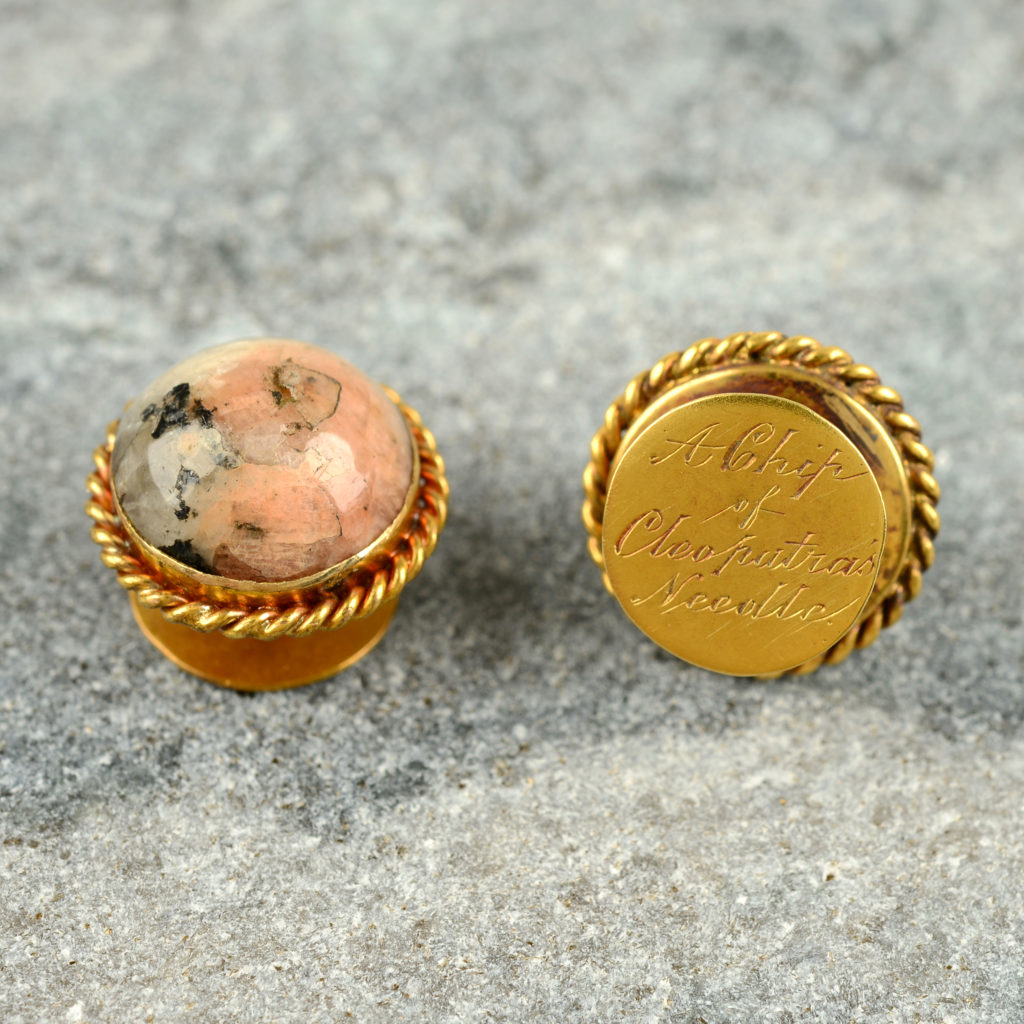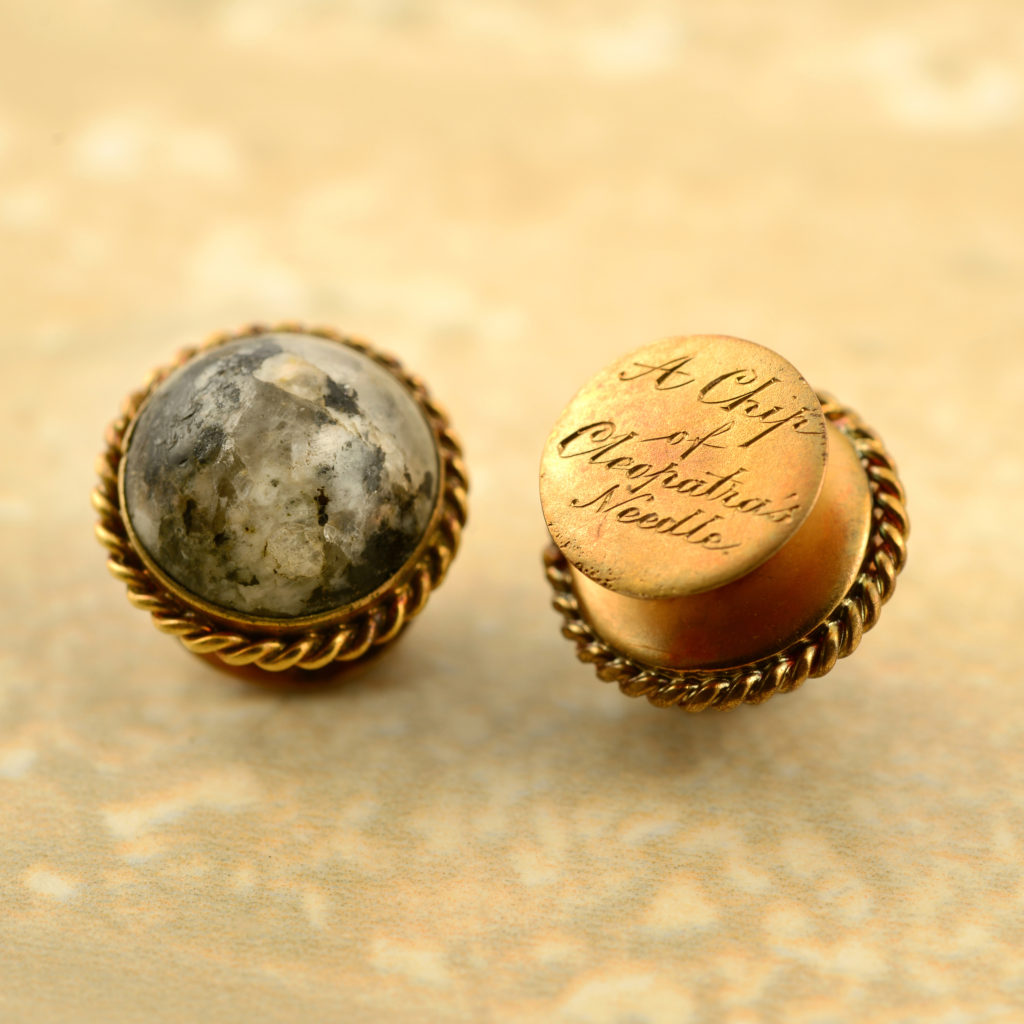A pair of granite dress studs which we sold in February's Fine Jewellery auction carry a story that spans more than three millennia. Engraved to the reverse of their surround with ‘A Chip of Cleopatra’s Needle’, the studs are the encapsulation of Victorian excitement about the saga of Cleopatra’s Needle. It is a granite ancient Egyptian obelisk now located on the Thames Embankment in London.
History of Cleopatra’s Needle
The Thames obelisk is one of a pair from the ancient city of Heliopolis. Both needles date to around 1450 BC, as identified from their columns of inscriptions from the reign of New Kingdom pharaoh Thutmose III. The huge pieces of granite were both more than 20 metres long in their finished obelisk shape. These would have been transported with great effort from the quarries of Aswan, on the banks of the Nile. About 200 years after their first inscription, Ramesses II added more inscriptions to commemorate his military victories.
The obelisks’ link to Cleopatra came much later, when the pair were moved from Heliopolis to Alexandria in 12 BC. The Romans erected them in the Caesareum, a temple built earlier in the first century BC by Cleopatra to honour either Julius Caesar or Mark Antony. Both needles have since been known as ‘Cleopatra’s Needles’. Years later, the needles were toppled into the sand, unintentionally protecting their inscribed faces from centuries of weathering.
In 1819...
In 1819, the Sultan of Egypt and Sudan, Muhammad Ali Pasha, split the pair by presenting one needle to Great Britain. This is in recognition of the Victories over the French in Egypt of Lord Nelson in the battle of the Nile, in 1798, and Sir Ralph Abercromby in the battles of Alexandria, in 1801.
However, the gift proved too great – quite literally. This was because the needle weighed 224 tonnes and its cost for transportation was considered prohibitive by the British government. For 59 years, the needle remained in Alexandria. In the meantime, another needle was gifted to France and erected in Paris in 1836. This was referred to as Cleopatra’s Needle, but from Luxor and not of the Alexandria pair. Potentially spurred on by France’s needle, wealthy anatomist and dermatologist – and hobbyist Egyptian antiquarian – Sir William James Erasmus Wilson came to the rescue by sponsoring the transportation of the needle to Britain.
Cleopatra’s Needle in England
News of its impending arrival and the great lengths teams were going to to get it ready stirred public interest in the needle. The London Illustrated News featured daily picture and text updates on the encasing of the needle in a 28-metre iron cylinder its lowering and move into a floating frame, dubbed the Cleopatra, with mast, rudder and deck house, and its pull into the sea to be towed to London by ship. Excited Londoners also visited a wooden replica of the needle erected outside the Houses of Parliament, its original intended home.
The storm...
All was nearly lost, though; a storm at sea rocked the needle’s vessel uncontrollably and the rescue boat sent out from the ship to steady it capsized. This claimed the lives of the six crew members aboard. These sailors are commemorated with a plaque bearing their names at the base of the needle on Embankment. The ship crew abandoned the floating Cleopatra, fearing it would sink and was beyond saving. However it stayed afloat and was rescued four days later by trawlers. After this it was then collected by a paddle tugboat and taken to Spain for repairs.
The suspense of the journey captivated readers in Britain, who eagerly awaited its arrival in the Thames. School children in Gravesend, at the mouth of the Thames, were given the day off. This was to watch the trawler pull the Cleopatra into the estuary. After it was carefully uncased, Cleopatra’s needle was hauled into its new position, flanked either side by bronze sphinxes. In September 1878, one of the pair had a new home. This was nearly 60 years after it was gifted and 3300 years after its first raisin. Coincidentally, the second needle was gifted in 1877, the year before the London needle arrived to the United States. This was in recognition of ongoing friendship with Egypt, whilst, ironically, the British and the French endeavoured to take control of the Egyptian government. Also known as Cleopatra’s Needle, this needle was erected in Central Park in 1881.
A chip of Cleopatra's Needle at auction

This pair of dress studs with granite supposedly chipped from the London needle. This demonstrates the Victorian fascination with the story of the ancient needle and its journey. Undoubtedly, it was created in a very small number. The studs played into the Victorian trend for collecting items of historical and cultural value. With their ancient and modern history, the studs were the ultimate memento. This sentiment is as true today as it was in 1878.
In February 2023, we sold the dress studs for a total price realised of £754, including fees.













